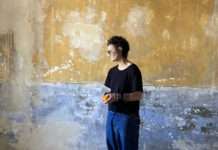- Environmentalists have long been promoting the benefits of wood toys, especially over their plastic counterparts that create massive waste. Plastic toys are often produced cheaply, break easily, are thrown away quickly, and can take hundreds of years to decompose.
- The 87-year-old artisan wood worker known affectionately Mr. Tops has been creating and selling traditional Ecuadorian toys here for over 50 years.
QUITO, Ecuador – Tucked away in Quito’s historical center, along the narrow sidewalks and colonial architecture, is Jorge Rivadeneira Granda’s workshop. It is the only storefront on the street with an oversized spinning top installed above the door.
The 87-year-old artisan wood worker known affectionately as Senor de los Trompos (Mr. Tops) has been creating and selling the traditional Ecuadorian toys here for over 50 years. Once a familiar hallmark of the city’s distinct culture, today Mr. Tops and his toys are a dying breed. He is one of the last artisans in the country’s capital city of Quito selling the toy.
Rivadeneira is also a master at making the tops “dance.” Over the years, he’s developed more than 40 different spinning techniques for the diminutive toys. He even won a world spinning championship in 1995. Some of his techniques include spinning the toy on top of his head, on a spoon poised in his mouth, or at the end of a long pole balanced on his lips. He claims that the latter is the most challenging since it could fall on his head at any moment.
There’s a celebrity status that comes with his talents. In fact, Rivadeneira gets hired regularly to do demonstrations for tourists at hotels, at special events in the city, and for private parties. He also frequently appears in the local media.
“My children say that when I do demonstrations of the top game, I look like a child,” Rivadeneira said, grinning. He added that people usually seem to get a lot of joy of watching him perform, which he finds hugely satisfying. “I like to please people.”
A lifetime obsession
Rivadeneira’s career as a woodworker began at eight years old when his carpenter father taught him the basics of working with natural wood material. By the time he was 12, he and his brother had developed an elaborate system to make tops using their manual lathe since they didn’t have electricity at the time. They then sold them to the kids in their school and played in the school yard.
“I always knew I wanted to create,” Rivadeneira told Mongabay recently, surrounded by hundreds of his creations in his workshop. “I modified [the tops] so they would be better than my father’s.”
He has kept at it for a long time.

Rivadeneira has worked with wood for his entire life, making everything from drumsticks for orchestras, batons for army generals, picture frames, plates, chess sets, teetotums, as well as trains and other toys. He can rattle off a list of the species of woods he’s worked with over the years.
But his favorite is the wood of the white guayacan tree (Tabebuia chrysantha), which is both durable and easy to work with – perfect for tops.
Because of its properties, the guayacan was once a popular tree used for its lumber. Today, efforts are being made for its conservation. The tree is one of several species belonging to the Bignoniaceae family that grows in the dry tropical forests from Mexico to Peru. It is known for its yellow flowers that bloom once a year, only for a few days.
The largest guayacan forests of Ecuador are found in the southern provinces of El Oro and Loja and draw thousands of tourists each year.
Wood vs. plastic
Environmentalists have long been promoting the benefits of wood toys, especially over their plastic counterparts that create massive waste. Plastic toys are often produced cheaply, break easily, are thrown away quickly, and can take hundreds of years to decompose.
This waste build-up is becoming a major environmental issue, as many plastic toys contain toxic metals used to stabilize the plastic or as coloring agents, which are then released in the atmosphere when they are burnt in landfills or are reproduced when they are recycled. Some of these include lead and zinc, which are used in soft toys such as bath toys, squeeze toys and teething rings, according to a study released in the Journal of Taibah University for Science in 2017.
Plastic began to take over the toy market in the 1950’s, when all the major toy companies – like Fisher-Price, Lego, and Mattel – started introducing the cheaper and more malleable material into their products. Eventually plastics became more popular than wood.

Rivadeneira says that people don’t value wooden toys the way they used to. He still makes a wide range of toys from train sets to trinkets, but only upon special order. If people see the toys already made, they always try to barter a lower price and don’t value the time involved in crafting each one of them, he says.
There has been growing research on the role of traditional toys like Rivadeneira’s in child development.
One study released by the American Academy of Pediatrics in 2018 noted that children’s creativity is enhanced by playing with the “most basic and inexpensive toys.” That includes things like wooden blocks, puzzles, crayons, and tops. These types of toys tend to foster more participation from parents, and lead to more open playing without restrictions or set guidelines. This is the opposite of playing with action figures, for example, which already have defined personalities and a set the course of play.
Some of the benefits of this include improvements in, “language, early math skills (numerosity and spatial concepts), social development, peer relations, physical development and health,” among others, according to the AAP.
The historic tradition of spinning tops is one example of this, as the game used to be played by both kids and adults in playgrounds, backyards and public squares. But today, these moments only come alive when Rivadeneira does one of his demonstrations.
Preserving tradition
Mr. Tops isn’t the only wooden toy holdout in Quito.
Susana Simbana says her wood creations unite families. Simabana recently started making her own 3D puzzles and other toys, in an attempt to revive this traditional culture. When she sells her puzzles at markets, she sees kids asking their parents for help and the whole family trying to figure out the problem together.

“Technology is good, but this is a product that unites families,” Simbana told Mongabay from the family workshop in her backyard in Quito’s suburb of Tumbaco. “My wooden toys give you health, they give you energy, and they don’t contaminate the environment.”
Simbana began making 3D puzzles two years ago after she was diagnosed with breast cancer and her doctor advised her to find ways to reduce stress and take her mind off her illness. She began crafting, using the wood scraps from her husband’s carpentry projects. Her first project was a 3D puzzle of a mouse, a replication of the toys her husband Ignacio Alcivar made for their two daughters when they were young.
When Simbana lost her job four months ago, she decided to use it as an opportunity to take her craft to the next level, and Multi Arte was born. She sold over 300 pieces during the recent holiday season, enough to feel encouraged to go on, she says.
One of the most common types of wood Simbana works with is the Laurel (Cordia alliodora), a softer wood her husband uses to make furniture, window frames and doors. This is a popular wood used for construction in Ecuador, as the trees grow relatively fast, can be cut down after 8-10 years, and are frequently reforested, according to Jose Cholango, who works at a lumber yard in Tumbaco.

Another popular wood that Simbana works with is the Colorado (Guarea macrophylla), a more durable wood that Alcivar uses to make trays, plates and chopping boards.Both of these are found in Ecuador’s northern Amazon rainforest.
Simbana says it’s important that her toys are sustainable, have little impact on forests, and are safe for children, so she never paints them and uses beeswax to coat her products, a trick she learned from her grandfather when she was growing up.
This is much safer than many plastic toys. Earlier this year, a UK study found numerous hazardous materials in several kinds of plastic toys, including blocks, cars, trains and action figures. The researchers found antimony, barium, bromine, cadmium, chromium, lead and selenium, all of which can be toxic to children, who often put toys in their mouth.
The young couple said they would like to make tops someday, and bring back a bit of their childhood when they made the tops dance with their cousins.
Banner image:Some of Susana Simbana’s wooden creations. Photo by Kimberley Brown for Mongabay.
This story first appeared on Mongabay
South Africa Today – Environment
This article is licensed under a Creative Commons Attribution-NoDerivatives 4.0 International License.
You may republish this article, so long as you credit the authors and Mongabay, and do not change the text. Please include a link back to the original article.












